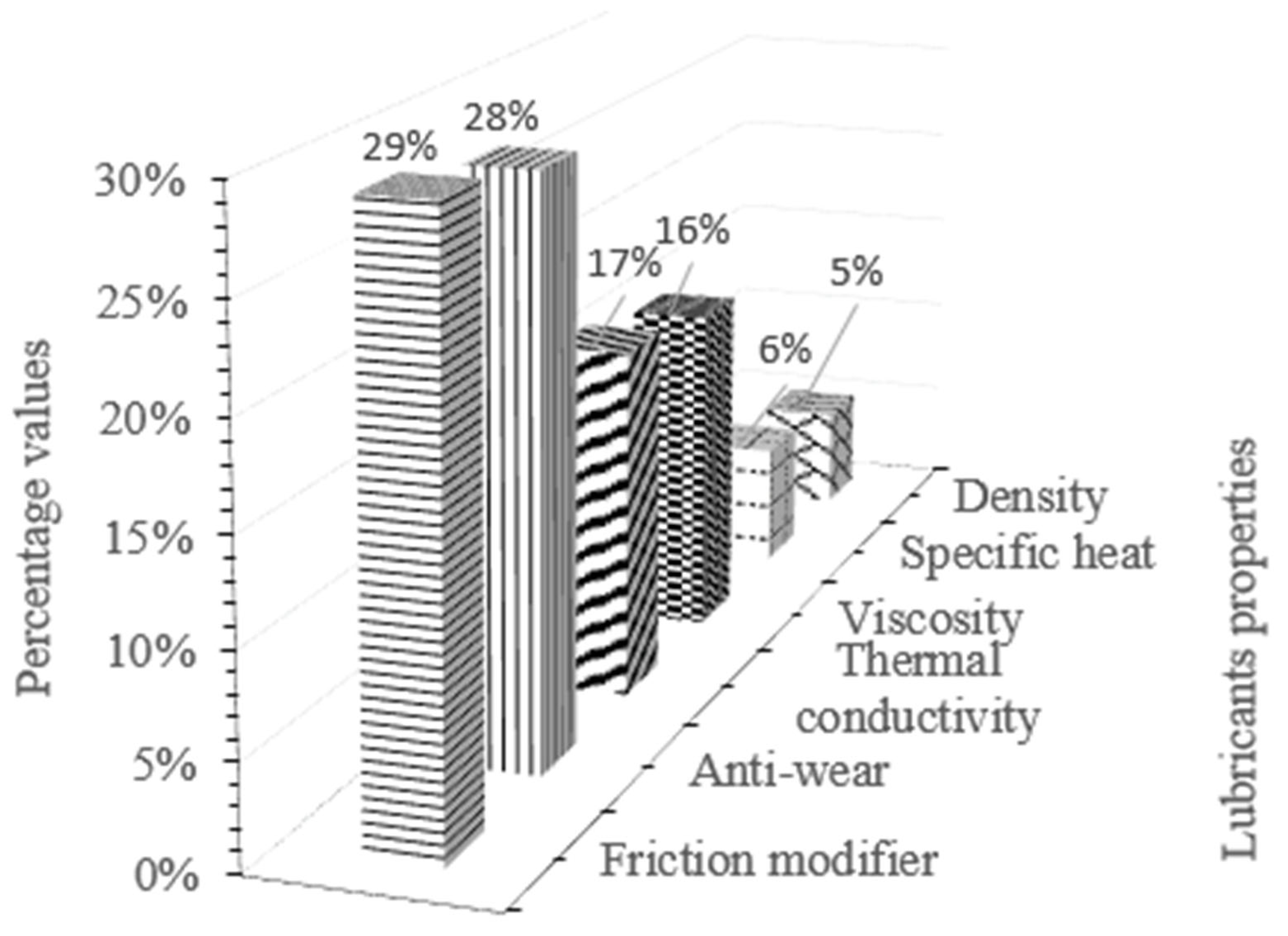Electric Vehicles as a Promising Trend: A Review on Adaptation, Lubrication Challenges, and Future Work
Abstract
1. Introduction
2. Brief Trends on the Development of EVs
3. EV Lubrication State of the Art
4. Major Bio-Lubricant Challenges
- Initiation (formation of free radicals)
- 2.
- Propagation or branching (chain reactions of free radicals)
- 3.
- Termination (formation of nonradical products)
- 4.
- Peroxide decomposition: ROO → Various lower molecular weight compounds
5. Major EV Components and Lubricant-Associated Challenges
5.1. Batteries and Motors
5.2. Elastomers Seals
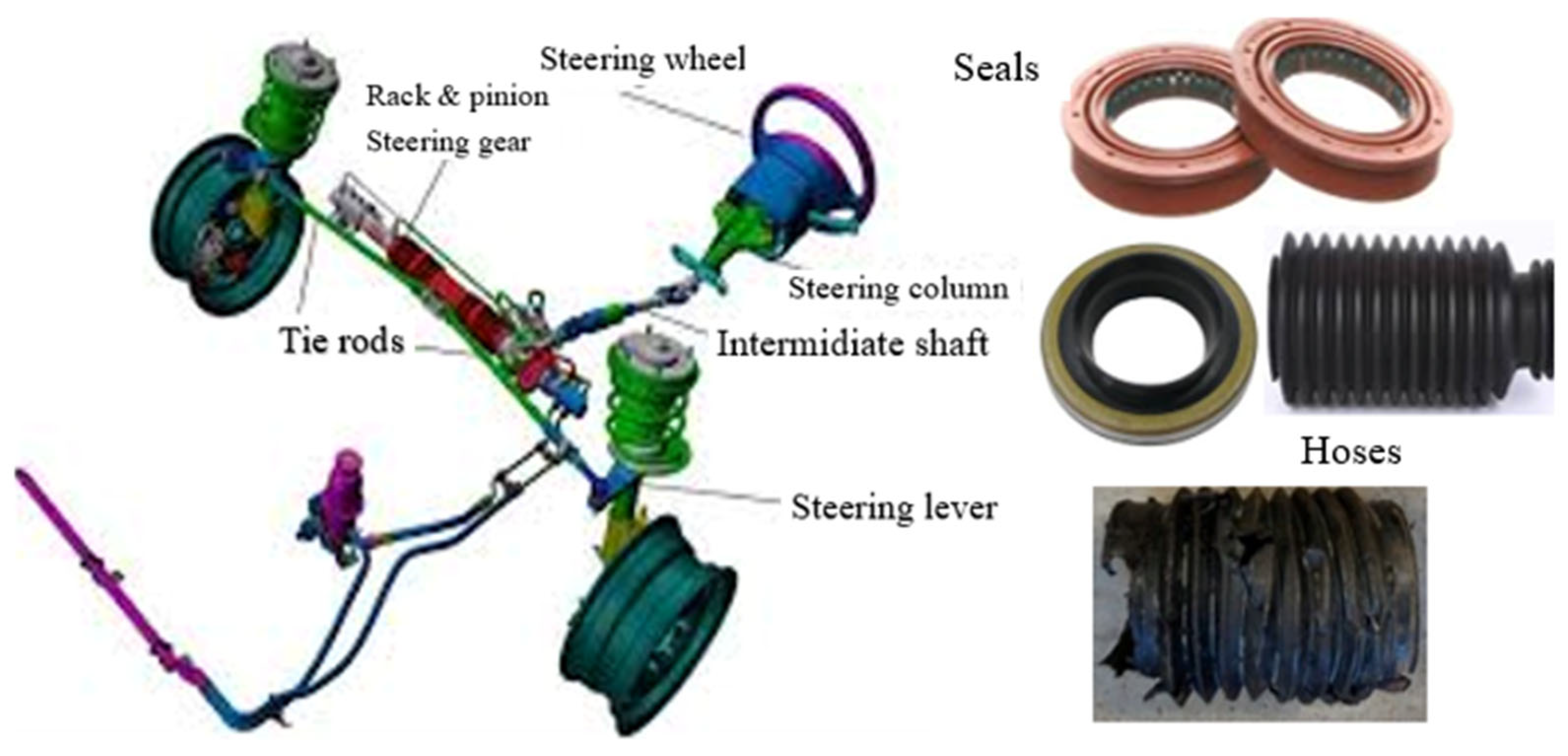
5.3. Constant-Velocity Joints
6. Formulation of Suitable Lubricants for EV Application
7. Future Work
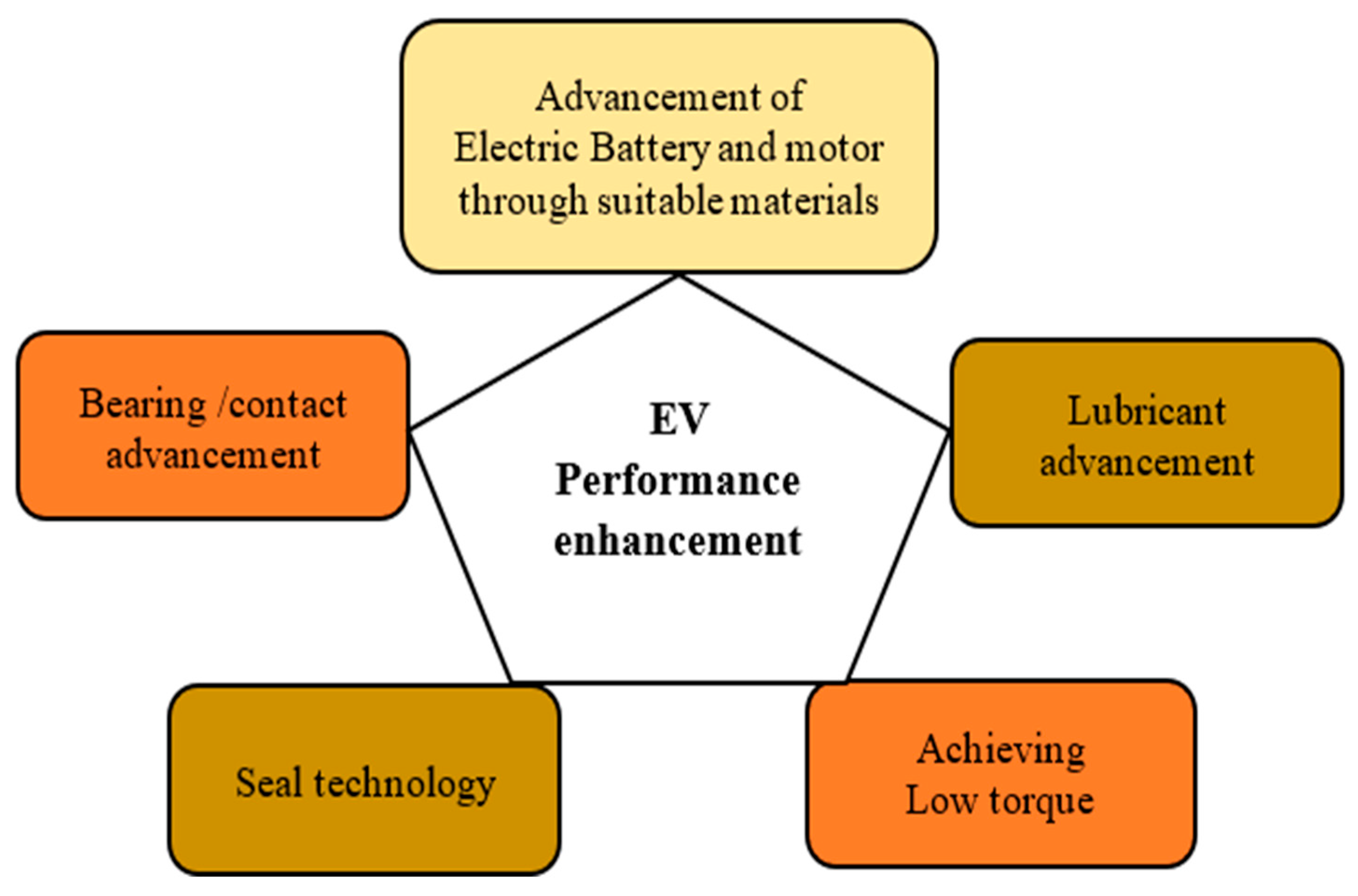
8. Conclusions
Author Contributions
Funding
Data Availability Statement
Acknowledgments
Conflicts of Interest
References
- Taylor, R.I. Energy efficiency, emissions, tribological challenges and fluid requirements of electrified passenger car vehicles. Lubricants 2021, 9, 66. [Google Scholar] [CrossRef]
- Delbeke, J.; Runge-Metzger, A.; Slingenberg, Y.; Werksman, J. The Paris Agreement. In Towards a Climate-Neutral Europe; Routledge: London, UK, 2021. [Google Scholar] [CrossRef]
- United Nations Office for Disaster Risk Reduction. The Intergovernmental Panel on Climate Change. 2020. Available online: https://www.ipcc.ch/2021/08/09/ar6-wg1-20210809-pr/ (accessed on 8 September 2025).
- Dillman, K.J.; Árnadóttir, Á.; Heinonen, J.; Czepkiewicz, M.; Davíðsdóttir, B. Review and Meta-Analysis of EVs: Embodied Emissions and Comment ? Environmental Breakeven. Sustainability 2016, 12, 9390. [Google Scholar] [CrossRef]
- He, F.; Xie, G.; Luo, J. Electrical bearing failures in electric vehicles. Friction 2020, 8, 4–28. [Google Scholar] [CrossRef]
- Chau, K.T.; Chan, C.C. Emerging energy-efficient technologies for hybrid electric vehicles. Proc. IEEE 2007, 95, 821–835. [Google Scholar] [CrossRef]
- Duncan, M.P. The Growth of Electric Vehicles. Tribol. Lubr. Technol. 2019, 75, 6. [Google Scholar]
- Foley, B.; Degirmenci, K.; Yigitcanla, T. Factors Affecting Electric Vehicle Uptake: Insights from a Descriptive Analysis in Australia. Urban Sci. 2020, 4, 57. [Google Scholar] [CrossRef]
- Sankarkumar, R.S.; Natarajan, R. Energy management techniques and topologies suitable for hybrid energy storage system powered electric vehicles: An overview. Int. Trans. Electr. Energy Syst. 2021, 31, e12819. [Google Scholar] [CrossRef]
- Opia, A.C.; Abdollah, M.F.; Hilmi, A. Lubricity performance of Jatropha oil incorporated PTFE and h-BN as additives for electric vehicles transmission lubrication. Industrial Lubrication and Tribology 2025, 77 (1), 93–104. [Google Scholar] [CrossRef]
- Chen, Y.; Jha, S.; Raut, A.; Zhang, W.; Liang, H. Performance Characteristics of Lubricants in Electric and Hybrid Vehicles: A Review of Current and Future Needs. Front. Mech. Eng. 2020, 6, 571464. [Google Scholar] [CrossRef]
- Belingardi, G.; Scattina, A. Battery Pack and Underbody: Integration in the Structure Design for Battery Electric Vehicles—Challenges and Solutions. Vehicles 2023, 5, 498–514. [Google Scholar] [CrossRef]
- Bukvić, M.; Milojević, S.; Gajević, S.; Đorđević, M.; Stojanović, B. Production Technologies and Application of Polymer Composites in Engineering: A Review. Polymers 2025, 17, 2187. [Google Scholar] [CrossRef]
- Annisa, A.N.; Widayat, W. A Review of Bio-lubricant Production from Vegetable Oils Using Esterification Transesterification Process. MATEC Web Conf. 2018, 156, 06007. [Google Scholar] [CrossRef]
- Opia, A.C. A Review on Bio-Lubricants as an Alternative Green Product: Tribological Performance, Mechanism, Challenges and Future Opportunities. Tribol. Online 2023, 18, 18–33. [Google Scholar] [CrossRef]
- Narita, K.; Takekawa, D. Lubricants Technology Applied to Transmissions in Hybrid Electric Vehicles and Electric Vehicles. In Proceedings of the 30th Internal Combustion Engine Symposium, Hiroshima, Japan, 19–21 November 2019; p. 2338. [Google Scholar] [CrossRef]
- Dassenoy, F. Nanoparticles as additives for the development of high performance and environmentally friendly engine lubricants. Tribol. Online 2019, 14, 237–253. [Google Scholar] [CrossRef]
- Ruliandini, R.; Nasruddin; Tokumasu, T. Assessing hbn nanoparticles stability in trimethylolpropane triester based biolubricants using molecular dynamic simulation. Evergreen 2020, 7, 234–239. [Google Scholar] [CrossRef]
- Aiman, Y.; Syahrullail, S.; Hafishah, H.; Musa, M.N. Friction characteristic study on flat surface embedded with micro pit. Evergreen 2021, 8, 304–309. [Google Scholar] [CrossRef]
- Ijaz, I.; Gilani, E.; Nazir, A.; Bukhari, A. Detail review on chemical, physical and green synthesis, classification, characterizations and applications of nanoparticles. Green Chem. Lett. Rev. 2020, 13, 59–81. [Google Scholar] [CrossRef]
- Al-Janabi, A.S.; Hussin, M.; Abdullah, M.Z. Stability, thermal conductivity and rheological properties of graphene and MWCNT in nanolubricant using additive surfactants. Case Stud. Therm. Eng. 2021, 28, 101607. [Google Scholar] [CrossRef]
- Leggiero, A.P.; Mubeen, S.; Bayram, C.; Kang, S.J.; Kong, J. High Conductivity Copper-Carbon Nanotube Hybrids via Site-Specific Chemical Vapor Deposition. ACS Appl. Nano Mater. 2019, 2, 118–126. [Google Scholar] [CrossRef]
- Beyer, M.; Hegemann, D.; Filser, T.; Gosvami, N.N.; Spikes, H.A.; Zobeiry, N.; Neubert, M.; Holz, T.; Müller, S. Lubricant concepts for electrified vehicle transmissions and axles. Tribol. Online 2019, 14, 428–437. [Google Scholar] [CrossRef]
- Cann, P.M. Grease lubrication of rolling element bearings—Role of the grease thickener. Lubr. Sci. 2007, 19, 183–196. [Google Scholar] [CrossRef]
- Andrew, J.M. The future of lubricating greases in the electric vehicle era. Tribol. Lubr. Technol. 2019, 75, 38–44. [Google Scholar]
- Wong, V.W.; Tung, S.C. Overview of automotive engine friction and reduction trends–Effects of surface, material, and lubricant-additive technologies. Friction 2016, 4, 1–28. [Google Scholar] [CrossRef]
- Lineira Del Río, J.M.; Morales, M.; Rubio, M.C.; Arroyo, M.; Olmos, S.; González, E.; Barrera, F.N. Tribological behavior of nanolubricants based on coated magnetic nanoparticles and trimethylolpropane trioleate base oil. Nanomaterials 2020, 10, 683. [Google Scholar] [CrossRef] [PubMed]
- Tazume, K. Oil Circulation System for an Electric Motor in a Hybrid Electric Vehicle. U.S. Patent No 9,458,841, 14 September 2016. [Google Scholar]
- Farfan-Cabrera, L.I. Tribology of electric vehicles: A review of critical components, current state and future improvement trends. Tribol. Int. 2019, 138, 473–486. [Google Scholar] [CrossRef]
- Romanenko, A.; Muetze, A.; Ahola, J. Effects of Electrostatic Discharges on Bearing Grease Dielectric Strength and Composition. IEEE Trans. Ind. Appl. 2016, 52, 4835–4842. [Google Scholar] [CrossRef]
- Gao, Z.; Salvi, L.; Flores-Torres, S. High Conductivity Lubricating Oils for Electric and Hybrid Vehicles. 2018. Available online: https://patents.google.com/patent/WO2018067906A1/en (accessed on 12 April 2025).
- Gupte, A. Characterization of Enginge and Transmission Lubricants for Electric, Hybrid and Plug-in Hybrid Vehicles. Econ. Reg. 2012, 2, 32. [Google Scholar]
- Sun, W.; He, Z.; He, D. Fault diagnosis of rolling bearing based on wavelet transform and envelope spectrum correlation. J. Vib. Control 2017, 21, 1–9. [Google Scholar] [CrossRef]
- Calderon Salmeron, G.; Leckner, J.; Schwack, F.; Westbroek, R.; Glavatskih, S. Greases for electric vehicle motors: Thickener effect and energy saving potential. Tribol. Int. 2022, 167, 107400. [Google Scholar] [CrossRef]
- Chen, Y. Recent developments of fluorescent probes for detection and bioimaging of nitric oxide. Nitric Oxide-Biol. Chem. 2020, 98, 1–19. [Google Scholar] [CrossRef]
- Lugt, P.M. On the Chaotic Behavior of Grease Lubrication in Rolling Bearings. Tribol. Trans. 2009, 52, 470–480. [Google Scholar] [CrossRef]
- Wang, Z.; Wei, S.; Zhang, Q. Analysis of multiple failure behaviors of steering knuckle ball hinge of multi-axle heavy vehicle. Adv. Mech. Eng. 2021, 225, 627–639. [Google Scholar] [CrossRef]
- Kanazawa, Y.; De Laurentis, N.; Kadiric, A. Studies of Friction in Grease-Lubricated Rolling Bearings Using Ball-on-Disc and Full Bearing Tests. Tribol. Trans. 2020, 63, 77–89. [Google Scholar] [CrossRef]
- Rahman, M.H.; Warnekr, H.; Ahamad, N.; Tang, G.; Mohamed, A.M.A. Water-Based Lubricants: Development, Properties, and Performances. Lubricants 2021, 13, 73. [Google Scholar] [CrossRef]
- El Bahi, H. A Comprehensive Approach of the Lubrication for the Electric Powertrain Based on an Innovative Multi-purpose Fluid. In Proceedings of the 18th International CTI SYMPOSIUM—Automotive Drivetrains, Intelligent, Electrified, Berlin, Germany, 9–12 December 2019; Springer Vieweg: Wiesbaden, Germany, 2021; pp. 80–92. [Google Scholar] [CrossRef]
- Derakhshandeh, M.R.; Eshraghi, M.J.; Jam, A.; Rajaei, H.; Fazili, A. Comparative studies on corrosion and tribological performance of multilayer hard coatings grown on WC-Co hardmetals. Int. J. Refract. Met. Hard Mater. 2020, 92, 1–21. [Google Scholar] [CrossRef]
- Jiang, C.; Yang, Y.; Cheng, X.; Zhao, J.; Li, X. Effect of Sn on the corrosion behavior of weathering steel in a simulated tropical marine atmosphere. Anti-Corros. Methods Mater. 2020, 67, 129–139. [Google Scholar] [CrossRef]
- Xie, C.; Wang, K. Synergistic modification of the tribological properties of polytetrafluoroethylene with polyimide and boron nitride. Friction 2021, 9, 1474–1491. [Google Scholar] [CrossRef]
- Narayanasarma, S.; Kuzhiveli, B.T. Evaluation of lubricant properties of polyolester oil blended with sesame oil-An experimental investigation. J. Clean. Prod. 2021, 281, 125347. [Google Scholar] [CrossRef]
- Rajaganapathy, C.; Vasudevan, D.; Murugapoopathi, S. Tribological and rheological properties of palm and brassica oil with inclusion of CuO and TiO2 additives. Mater. Today Proc. 2020, 37, 207–213. [Google Scholar] [CrossRef]
- Chen, Y.; Wang, X.; Clearfield, A.; Liang, H. Anti-galling effects of α-zirconium phosphate nanoparticles as grease additives. J. Tribol. 2019, 141, 031801. [Google Scholar] [CrossRef]
- Shah, R.; Gashi, B.; González-Poggini, S.; Colet-Lagrille, M.; Rosenkranz, A. Recent trends in batteries and lubricants for electric vehicles. Adv. Mech. Eng. 2021, 13, 16878140211021730. [Google Scholar] [CrossRef]
- Okechukwu, E.H.; Omoniyi, T.E.; Omotoso, M.A.; Oladele, A.K.; Ogunleye, O.O. Physicochemical characterization of the synthetic lubricating oils degradation under the effect of vehicle engine operation. Lubricants 2013, 20, 135–138. [Google Scholar] [CrossRef][Green Version]
- McNutt, J.; He, Q.S. Development of biolubricants from vegetable oils via chemical modification. J. Ind. Eng. Chem. 2016, 36, 1–12. [Google Scholar] [CrossRef]
- Erhan, S.Z.; Sharma, B.K.; Perez, J.M. Oxidation and low temperature stability of vegetable oil-based lubricants. Ind. Crops Prod. 2006, 24, 292–299. [Google Scholar] [CrossRef]
- Sharma, B.K.; Adhvaryu, A.; Liu, Z.; Erhan, S.Z. Chemical modification of vegetable oils for lubricant applications. JAOCS J. Am. Oil Chem. Soc. 2006, 83, 129–136. [Google Scholar] [CrossRef]
- Girisuta, B.; Danon, B.; Manurung, R.; Janssen, L.; Heeres, H.J. Experimental and kinetic modelling studies on the acid-catalysed hydrolysis of the water hyacinth plant to levulinic acid. Bioresour. Technol. 2008, 99, 8367–8375. [Google Scholar] [CrossRef] [PubMed]
- Scrimgeour, C.; Akoh, C.C. Chemistry of Fatty Acids. In Bailey’s Industrial Oil and Fat Products; Wiley: New York, NY, USA, 2020. [Google Scholar] [CrossRef]
- Lubis, A.M.H.S.; Ariwahjoedi, B.; Sudin, M.B. Investigation on oxidation of jatropha oil. In Proceedings of the Mechanical Engineering Research Day 15 (MERD’15), Melaka, Malaysia, 31 March 2015; Volume 58, p. 2011. Available online: https://www.researchgate.net/publication/343295047_Investigation_on_oxidation_of_jatropha_oil (accessed on 12 June 2025).
- Shahbazi, K.; Mehta, S.A.; Moore, R.G.; Ursenbach, M.G. The effect of oxidation on viscosity of oil-based drilling fluids. J. Can. Pet. Technol. 2006, 45, 41–46. [Google Scholar] [CrossRef]
- Mannekote, J.K.; Kailas, S.V. The effect of oxidation on the tribological performance of few vegetable oils. J. Mater. Res. Technol. 2012, 1, 91–95. [Google Scholar] [CrossRef]
- Bin Abdollah, M.F.; Amiruddin, H.; Alif Azmi, M.; Mat Tahir, N.A. Lubrication mechanisms of hexagonal boron nitride nano-additives water-based lubricant for steel–steel contact. Proc. Inst. Mech. Eng. Part J J. Eng. Tribol. 2021, 235, 1038–1046. [Google Scholar] [CrossRef]
- Lijesh, K.P.; Muzakkir, S.M.; Hirani, H. Experimental tribological performance evaluation of nano lubricant using multi-walled carbon nano-tubes (MWCNT). Int. J. Appl. Eng. Res. 2015, 10, 14543–14550. [Google Scholar]
- Nasreen, K.; Blair, B. Intermolecular Interactions in Polyelectrolyte and Surfactant Complexes in Solution. Polymers 2019, 13, 51. [Google Scholar]
- Gulzar, M.; Masjuki, H.H.; Varman, M.; Kalam, M.A.; Mufti, R.A.; Zulkifli, N.W.M.; Yunus, R.; Zahid, R. Improving the AW/EP ability of chemically modified palm oil by adding CuO and MoS2 nanoparticles. Tribol. Int. 2015, 88, 271–279. [Google Scholar] [CrossRef]
- Lipman, T.E.; Maier, P. Advanced materials supply considerations for electric vehicle applications. MRS Bull. 2021, 46, 1164–1175. [Google Scholar] [CrossRef]
- Kim, Y.S.; Lee, S.H.; Son, M.Y.; Jung, Y.M.; Song, H.K.; Lee, H. Succinonitrile as a corrosion inhibitor of copper current collectors for overdischarge protection of lithium ion batteries. ACS Appl. Mater. Interfaces 2014, 6, 2039–2043. [Google Scholar] [CrossRef]
- Saba, F.; Zhang, F.; Liu, S.; Liu, T. Tribological properties, thermal conductivity and corrosion resistance of titanium/nanodiamond nanocomposites. Compos. Commun. 2018, 10, 57–63. [Google Scholar] [CrossRef]
- Pesaran, A.; Santhanagopalan, S.; Kim, G.-H. Addressing the Impact of Temperature Extremes on Large Format Li-Ion Batteries for Vehicle Applications (Presentation), NREL (National Renewable Energy Laboratory). In Proceedings of the 30th International Battery Seminar & Exhibit, Fort Lauderdale, FL, USA, 11–14 March 2013; Available online: https://digital.library.unt.edu/ark:/67531/metadc834057/ (accessed on 22 March 2025).
- Wolfberger, A.; Zehl, M.; Hausberger, A.; Tockner, M.; Schlogl, S.; Hołyńska, M.; Semprimoschnig, C. Effect of Accelerated Aging on the Chemical Signature and Performance of a Multiply-Alkylated Cyclopentane (MAC) Lubricant for Space Applications. Tribol. Lett. 2021, 69, 3. [Google Scholar] [CrossRef]
- Aguilar, G.; Mazzamaro, G.; Rasberger, M. Oxidative degradation and stabilisation of mineral oil-based lubricants. In Chemistry and Technology of Lubricants, 3rd ed.; Springer: Dordrecht, The Netherlands, 2010; pp. 107–152. [Google Scholar] [CrossRef]
- Wu, Y.; Li, W.; Zhang, M.; Wang, X. Oxidative degradation of synthetic ester and its influence on tribological behavior. Tribol. Int. 2013, 64, 16–23. [Google Scholar] [CrossRef]
- Sun, K.; Zhong, W.; Huang, S.; He, X.; Cai, W.; Ma, R.; Jiang, T.; You, S.; Wang, L.; Li, W. Research Progress on the Corrosion Mechanism and Protection Monitoring of Metal in Power Equipment. Coating 2025, 15, 119. [Google Scholar] [CrossRef]
- Zulhanafi, P.; Syahrullail, S.; Faridzuan, M.M. The effect of saturated and unsaturated fatty acid composition in bio-based lubricant to the tribological performances using four-ball tribotester. J. Oil Palm Res. 2021, 33, 653–667. [Google Scholar]
- Almeida, A.P.P.; de Oliveira, A.P.L.R.; Erbetta, C.D.C.; de Sousa, R.G.; de Souza Freitas, R.F.; e Silva, M.E.S.R. Rheological Study of Polymers Used as Viscosity Index Improvers for Automotive Lubricant Oils. J. Mod. Phys. 2014, 5, 1085–1093. [Google Scholar] [CrossRef]
- Huang, B.; Li, X.; Cheng, H. Study Rheological Behavior of Polymer Solution in Different-Medium-Injection-Tools. Polymers 2019, 11, 319. [Google Scholar] [CrossRef]
- Tung, S.C.; McMillan, M.L. Automotive tribology overview of current advances and challenges for the future. Tribol. Int. 2004, 37, 517–536. [Google Scholar] [CrossRef]
- Ali, M.K.A.; Xianjun, H.; Mai, L.; Qingping, C.; Turkson, R.F.; Bicheng, C. Improving the tribological characteristics of piston ring assembly in automotive engines using Al2O3 and TiO2 nanomaterials as nano-lubricant additives. Tribol. Int. 2016, 103, 540–554. [Google Scholar] [CrossRef]
- Feng, X.; He, X.; Ouyang, M.; Wang, L.; Lu, L.; Ren, D.; Santhanagopalan, S. A Coupled Electrochemical-Thermal Failure Model for Predicting the Thermal Runaway Behavior of Lithium-Ion Batteries. J. Electrochem. Soc. 2018, 165, A3748–A3765. [Google Scholar] [CrossRef]
- Feng, X.; Zheng, S.; Ren, D.; He, X.; Wang, L.; Cui, H.; Liu, X.; Jin, C.; Zhang, F.; Xu, C.; et al. Investigating the thermal runaway mechanisms of lithium-ion batteries based on thermal analysis database. Appl. Energy 2019, 246, 53–64. [Google Scholar] [CrossRef]
- McKerracher, R.D.; Guzman Guemez, J.; Wills, R.; Kramer, D.; Sharkh, S.M. Advances in Prevention of Thermal Runaway in Lithium-Ion Batteries. Adv. Energy Sustain. Res. 2021, 74, 535–546. [Google Scholar] [CrossRef]
- Galushkin, N.E.; Yazvinskaya, N.N.; Galushkin, D.N. Mechanism of Thermal Runaway in Lithium-Ion Cells. J. Electrochem. Soc. 2018, 165, A1303–A1308. [Google Scholar] [CrossRef]
- Carrell, J. The Feasibility of Bio-Lubricants as Automotive Engine Oils. Ph.D. Thesis, University of Sheffield, Sheffield, UK, 2019. [Google Scholar]
- Robert, P.E.; Tata, P. Principles and use of Gears, Shafts and Bearings; Continuing Education & Development, Inc.: Grand Rapids, MI, USA, 2011. [Google Scholar]
- Shara, S.I.; Eissa, E.A.; Basta, J.S. Polymers additive for improving the flow properties of lubricating oil. Egypt. J. Pet. 2018, 27, 795–799. [Google Scholar] [CrossRef]
- Dandan, M.A.; Samion, S.; Azman, N.F.; Mohd Zawawi, F.; Abdul Hamid, M.K.; Musa, M.N. Performance of polymeric viscosity improver as bio-lubricant additives. Int. J. Struct. Integr. 2019, 10, 634–643. [Google Scholar] [CrossRef]
- Opia, A.C.; Abdollah, M.F.B.; Mamah, S.C.; Hamid, M.K.A.; Audu, I.A.; Johnson, C.N.; Veza, I.; Ahmed, S. Tribological Performance Evaluation of Blended Lubricants Incorporated with Organic Polymer. Tribol. Online 2023, 18, 64–77. [Google Scholar] [CrossRef]
- Teplická, K.; Khouri, S.; Mudarri, T.; Freňáková, M. Improving the Quality of Automotive Components through the Effective Management of Complaints in Industry 4.0. Appl. Sci. 2023, 53, 8402. [Google Scholar] [CrossRef]
- Lu, P.; Wood, R.J.K.; Gee, M.G.; Wang, L.; Pfleging, W. The friction reducing effect of square-shaped surface textures under lubricated line-contacts-an experimental study. Lubricants 2016, 4, 26. [Google Scholar] [CrossRef]
- Ibatan, T.; Uddin, M.S.; Chowdhury, M.A.K. Recent development on surface texturing in enhancing tribological performance of bearing sliders. Surf. Coat. Technol. 2015, 272, 102–120. [Google Scholar] [CrossRef]
- Dhinesh, B.; Annamalai, M.; Lalvani, I.J.R.; Annamalai, K. Studies on the influence of combustion bowl modification for the operation of Cymbopogon flexuosus biofuel based diesel blends in a DI diesel engine. Appl. Therm. Eng. 2017, 112, 627–637. [Google Scholar] [CrossRef]
- Soltani, M.E.; Shams, K.; Akbarzadeh, S.; Ruggiero, A. A Comparative Investigation on the Tribological Performance and Physicochemical Properties of Biolubricants of Various Sources, a Petroleum-Based Lubricant, and Blends of the Petroleum-Based Lubricant and Crambe Oil. Tribol. Trans. 2020, 63, 1121–1134. [Google Scholar] [CrossRef]
- Makarova, O.V.; Rajh, T.; Thurnauer, M.C.; Martin, A.; Kemme, P.A.; Cropek, D. Surface modification of TiO2 nanoparticles for photochemical reduction of nitrobenzene. Environ. Sci. Technol. 2000, 34, 4797–4803. [Google Scholar] [CrossRef]
- Singh, G.; Aggarwal, V.; Singh, S. Critical review on ecological, economical and technological aspects of minimum quantity lubrication towards sustainable machining. J. Clean. Prod. 2020, 271, 122185. [Google Scholar] [CrossRef]
- Friedrich, K. Polymer composites for tribological applications. Adv. Ind. Eng. Polym. Res. 2018, 1, 3–39. [Google Scholar] [CrossRef]
- Wang, Z.; Shuai, S.; Li, Z.; Yu, W. A review of energy loss reduction technologies for internal combustion engines to improve brake thermal efficiency. Energies 2021, 14, 6656. [Google Scholar] [CrossRef]
- Nagaprasad, K.S.; Banapurmath, N.R.; Madhu, D.; Yunus Khan, T.M. Pre- and post-combustion emission reduction techniques for engine fuelled with diesel/DEE blends by three approaches. Energy Sources Part A Recovery Util. Environ. Eff. 2021, 43, 1706–1723. [Google Scholar] [CrossRef]
- Peskoe-Yang, L. Electric vehicles make grease’ s future uncertain. Tribol. Lubr. Technol. 2020, 76, 24–25. [Google Scholar]
- Korcek, S.; Sorab, J.; Johnson, M.D.; Jensen, R.K. Automotive lubricants for the next millennium. Ind. Lubr. Tribol. 2000, 52, 209–220. [Google Scholar] [CrossRef]
- Veza, I.; Asy’ari, M.Z.; Smith, J.A.; Lee, C.; Gupta, R.; Chen, Y.; Martínez, F.; Patel, D.; Brown, S.; Wilson, T. Electric vehicle (EV) and driving towards sustainability: Comparison between EV, HEV, PHEV, and ICE vehicles to achieve net zero emissions by 2050 from EV. Alex. Eng. J. 2023, 82, 459–467. [Google Scholar] [CrossRef]
- Nugroho, A.; Kozin, M.; Mamat, R.; Smith, J.A.; Lee, C.; Gupta, R.; Chen, Y.; Martínez, F.; Patel, D.; Brown, S.; et al. Enhancing tribological performance of electric vehicle lubricants: Nanoparticle-enriched palm oil bio-lubricants for wear resistance. Heliyon 2024, 10, e39742. [Google Scholar] [CrossRef] [PubMed]
- Nasser, K.; Smith, J.A.; Johnson, L.M.; Lee, C.; Gupta, R.; Chen, Y.; Martínez, F.; Patel, D.; Brown, S.; Wilson, T. Recent Studies on Nanomaterials as Additives to Lubricants Under Electrified Conditions for Tribology: Review. Lubricants 2025, 13, 2. [Google Scholar] [CrossRef]
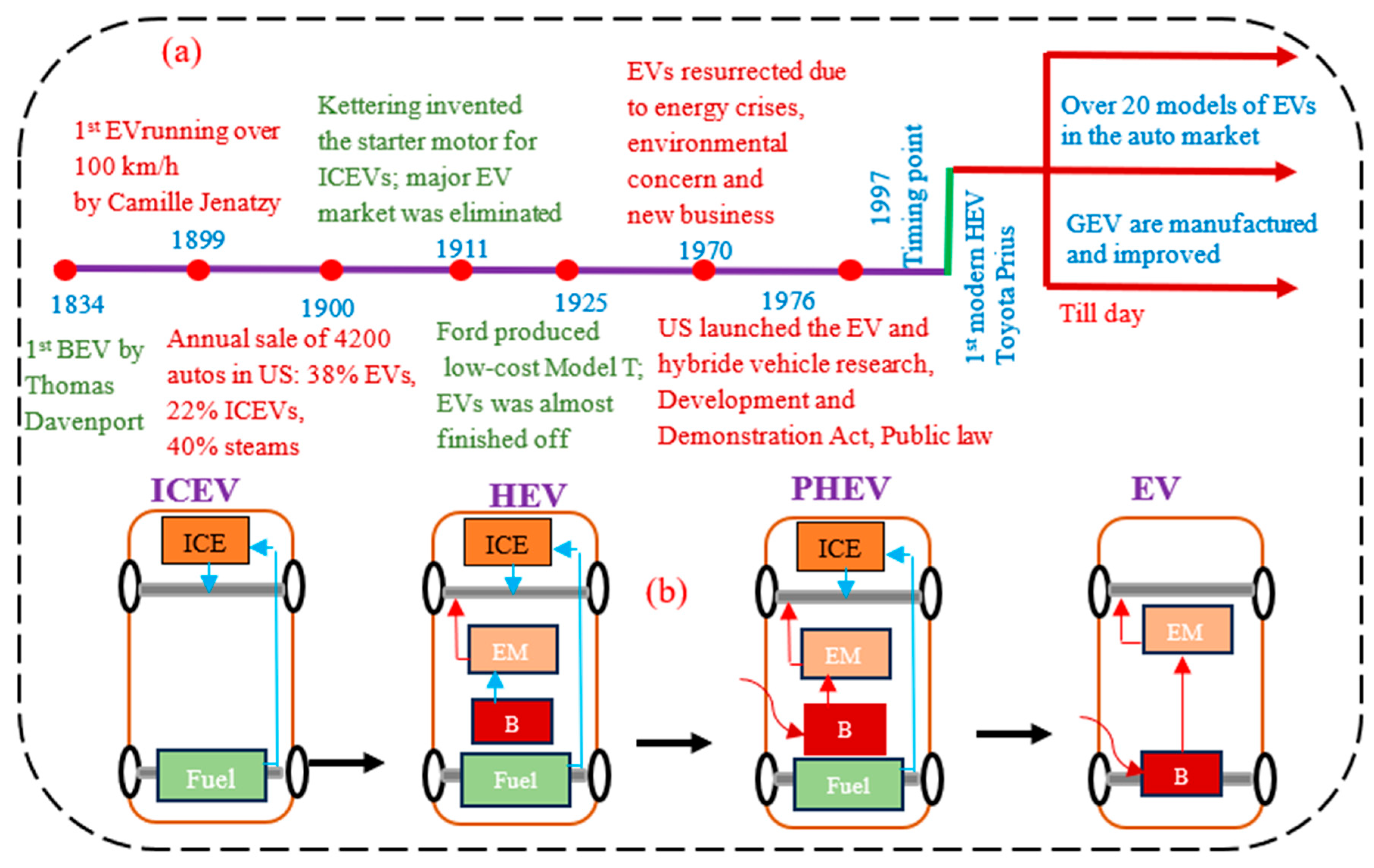
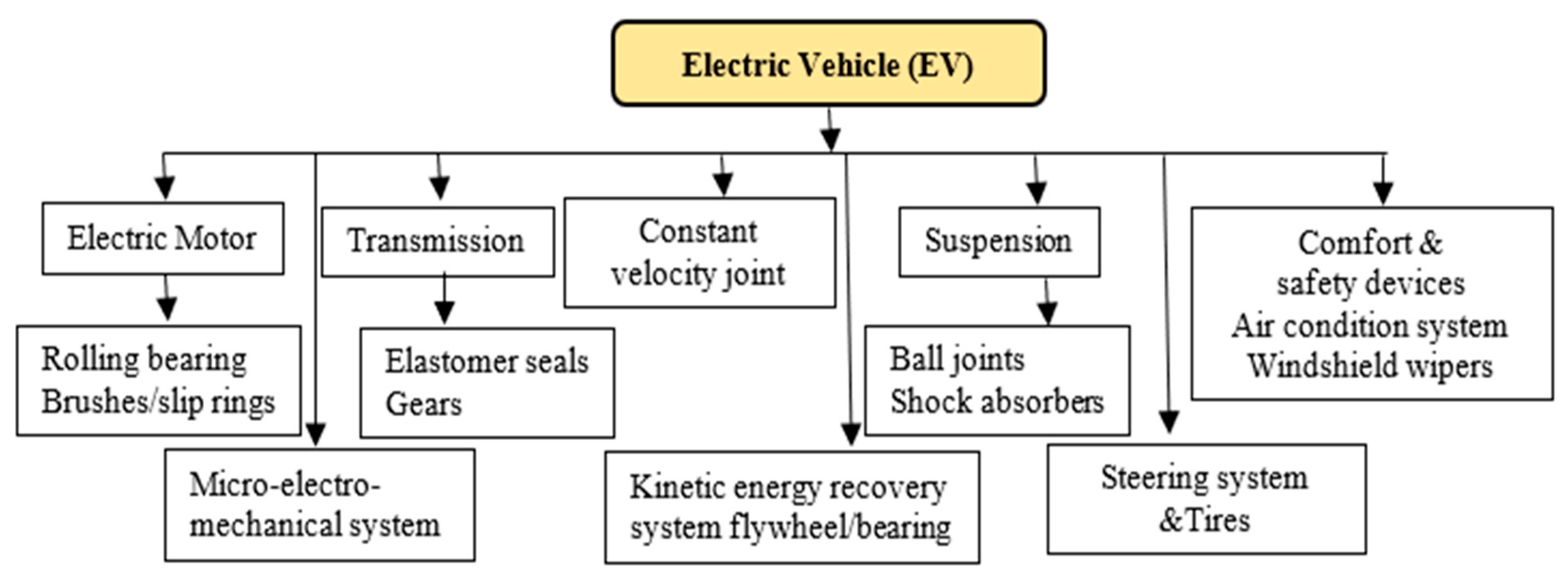

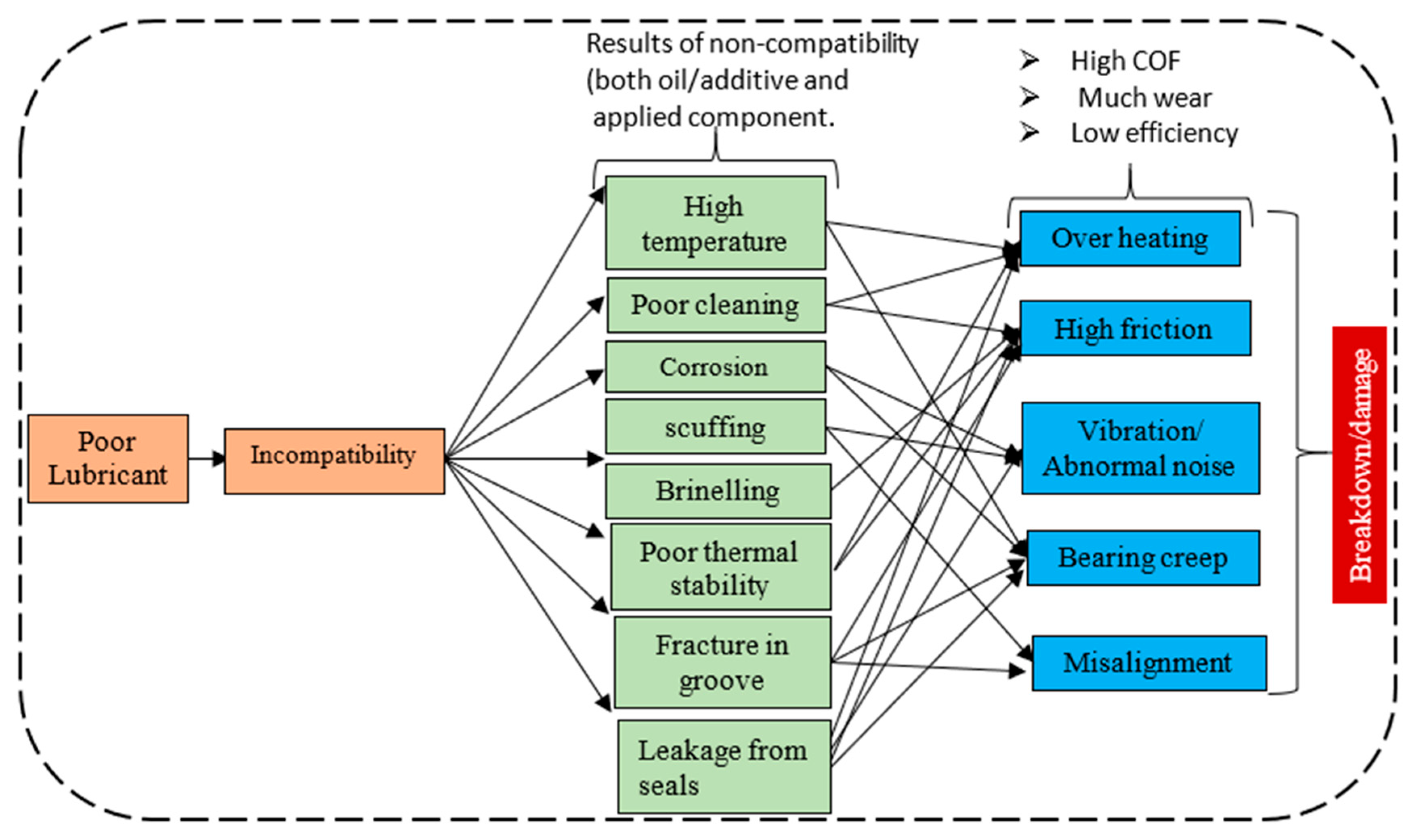
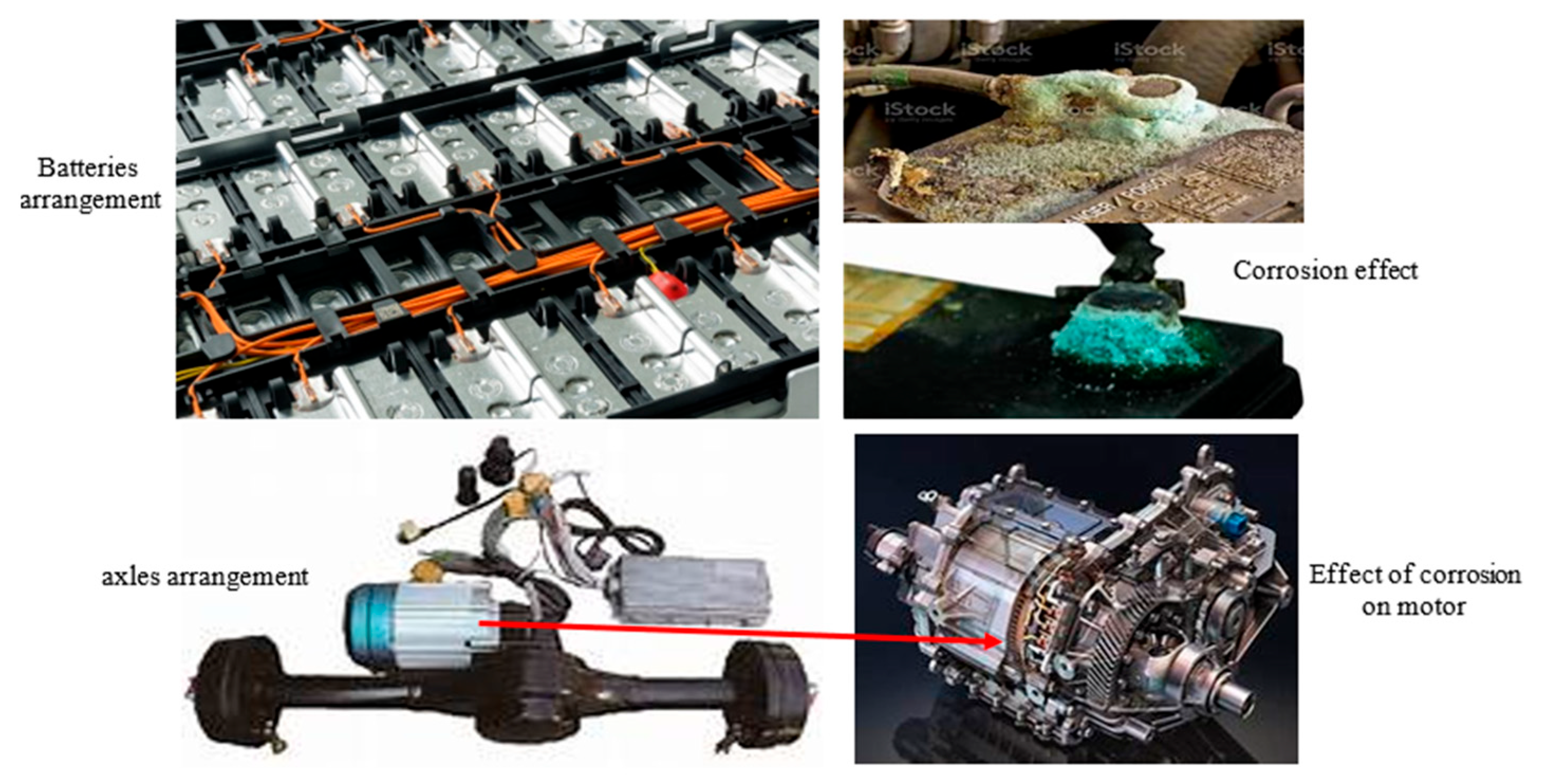
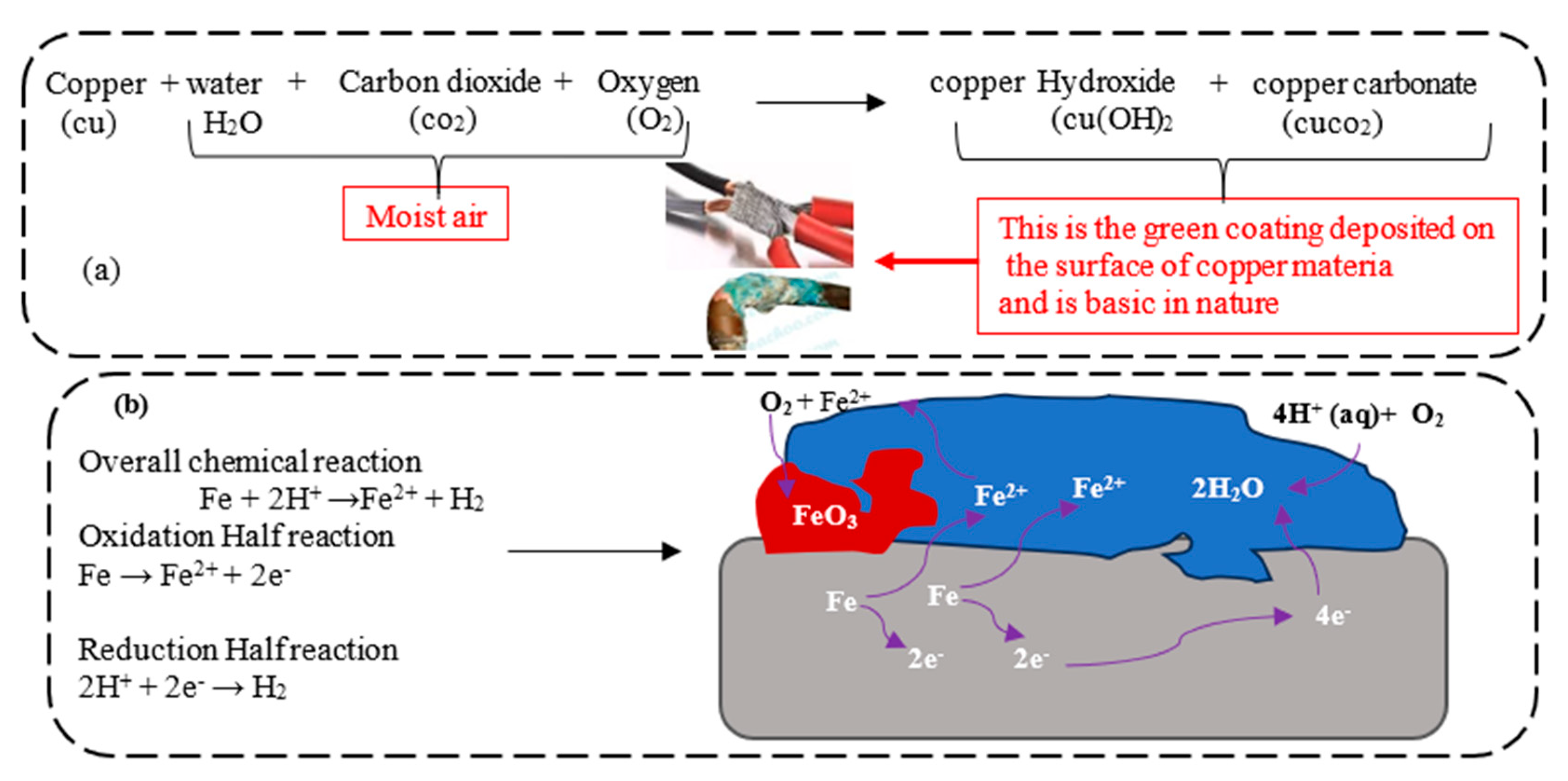
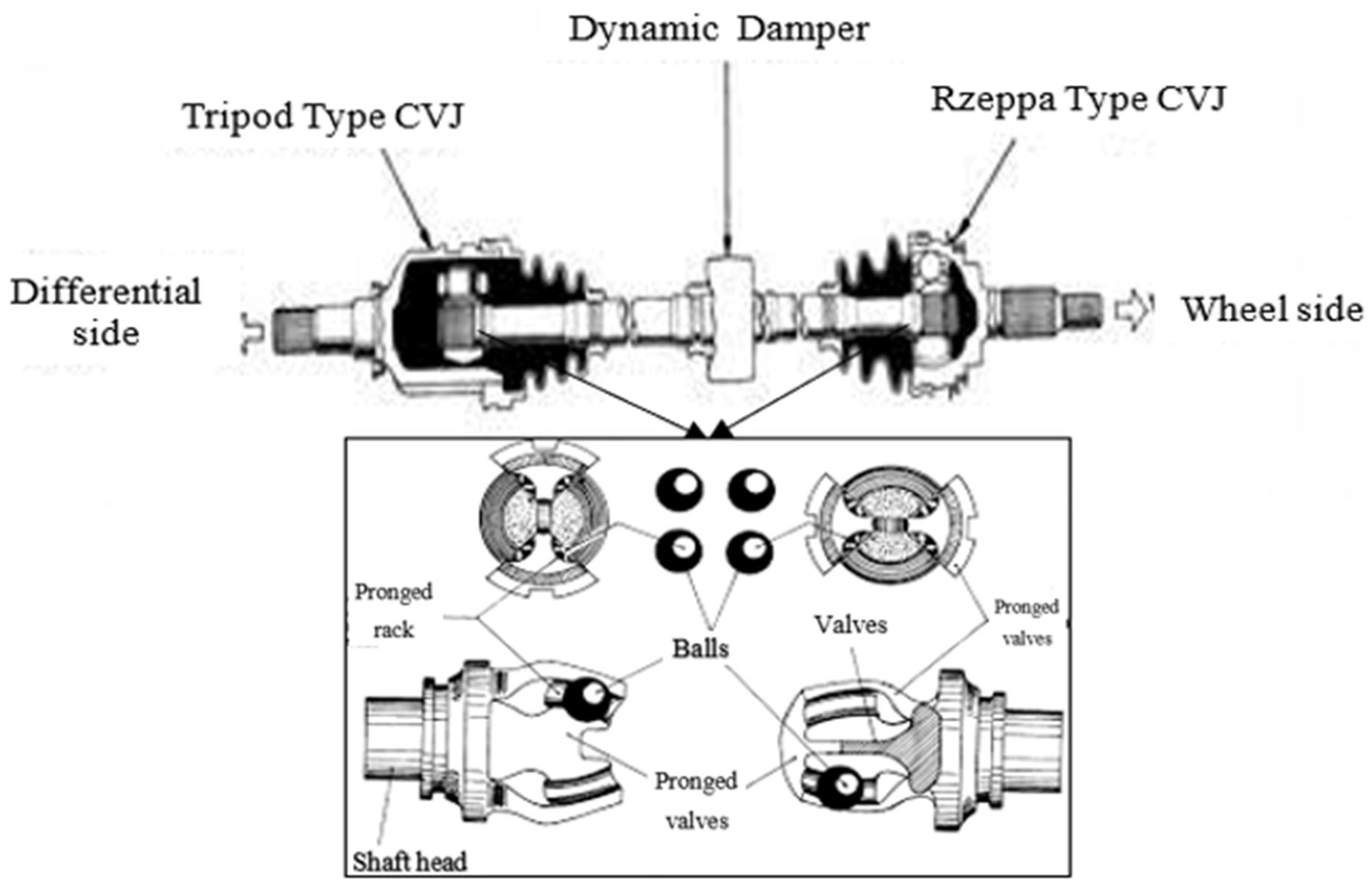

| No | Lubricants/ Materials | Analysis Technique | Thermal Conductivity | Corrosion Resistance | Tribological Performance | Remark | Ref. |
|---|---|---|---|---|---|---|---|
| 1 | TiN/TiCN/TiCN/TiC/Al2O3, and TiN/TiCN/TiCN/TiC/TiN coated samples | Samples prepared using CVD system, while the tribology test was performed under dry testing using pin-on-disk | N/A | TiN/TiCN/TiCN/TiC/Al2O3 coating exhibited more corrosion resistance than all other samples. This is because Al2O3 is more corrosion-resistant than TiN. | TiN/TiCN/TiCN/TiC/TiN-coated sample yielded more wear profile compared to TiN/TiCN/TiCN/TiC/Al2O3-coated sample. | Using at oxidative area, TiN/TiCN/TiCN/TiC/Al2O3-coated sample is recommended to avoid unwanted corrosion, which will lead to high COF and wear. | [41] |
| 2 | Additive Sn-free steel and additive Sn-containing steel | Electrochemical tests on weathering steel (WS) | N/A | Additive of Sn enhanced the corrosion resistance of WS in a simulated tropical marine atmosphere | N/A | When the WS is corroded, Sn participates in the formation of rust layer in the form of SnO2 and is mainly distributed in the inner rust layer. | [42] |
| 3 | polytetrafluoroethylene with polyimide and boron nitride | Dry sliding friction of a block-on-ring tribometer | PTFE has a low thermal conductivity of about 0.24 W/(m·K). | N/A | The wear rate and COF of the 10:10:80 BN/PI/PTFE composite reduced to almost 1/300 and 80% of those of pure PTFE, respectively. | In blending BN/PI/PTFE, the concentration of PTFE should be higher as to defend the operation from attack of corrosion. | [43] |
| 4 | polyol ester blended with sesame oil | Four ball tribometer | Maximum thermal conductivity was obtained at 85 °C for the blend B35 and is 25.73% more than that of the base POE oil | Resistance of corrosion under sesame oil blended than base form | Sesame oil blends have lower values of CoF and wear scar radius when compared to the base POE oil. | The use of the POE/sesame oil blended lubricants in contact with copper gives no risk of corrosion, thus could be applied in EVs and refrigeration. | [44] |
| 5 | Copper oxide (Cuo) nanoparticles and Titanium oxide (TiO2) nanoparticles | Pin-on-disk tribometer | Increase in concentration is liable for improvement of thermal conductivity of nano-bio-lubricants but better with copper oxide | N/A | With 0.5% Cuo, nanoparticles have lower coefficient of friction and specific wear rate compared to the rest of the nano-bio-lubricants. | Since the outcome yielded enhanced thermal conductivity, this implies that application on EVs close to the battery is not recommended to avoid current flow. | [45] |
Disclaimer/Publisher’s Note: The statements, opinions and data contained in all publications are solely those of the individual author(s) and contributor(s) and not of MDPI and/or the editor(s). MDPI and/or the editor(s) disclaim responsibility for any injury to people or property resulting from any ideas, methods, instructions or products referred to in the content. |
© 2025 by the authors. Licensee MDPI, Basel, Switzerland. This article is an open access article distributed under the terms and conditions of the Creative Commons Attribution (CC BY) license (https://creativecommons.org/licenses/by/4.0/).
Share and Cite
Opia, A.C.; Kadirgama, K.; Mamah, S.C.; Ghazali, M.F.; Harun, W.S.W.; Adeboye, O.J.; Agi, A.; Alibi, S. Electric Vehicles as a Promising Trend: A Review on Adaptation, Lubrication Challenges, and Future Work. Lubricants 2025, 13, 474. https://doi.org/10.3390/lubricants13110474
Opia AC, Kadirgama K, Mamah SC, Ghazali MF, Harun WSW, Adeboye OJ, Agi A, Alibi S. Electric Vehicles as a Promising Trend: A Review on Adaptation, Lubrication Challenges, and Future Work. Lubricants. 2025; 13(11):474. https://doi.org/10.3390/lubricants13110474
Chicago/Turabian StyleOpia, Anthony Chukwunonso, Kumaran Kadirgama, Stanley Chinedu Mamah, Mohd Fairusham Ghazali, Wan Sharuzi Wan Harun, Oluwamayowa Joshua Adeboye, Augustine Agi, and Sylvanus Alibi. 2025. "Electric Vehicles as a Promising Trend: A Review on Adaptation, Lubrication Challenges, and Future Work" Lubricants 13, no. 11: 474. https://doi.org/10.3390/lubricants13110474
APA StyleOpia, A. C., Kadirgama, K., Mamah, S. C., Ghazali, M. F., Harun, W. S. W., Adeboye, O. J., Agi, A., & Alibi, S. (2025). Electric Vehicles as a Promising Trend: A Review on Adaptation, Lubrication Challenges, and Future Work. Lubricants, 13(11), 474. https://doi.org/10.3390/lubricants13110474






